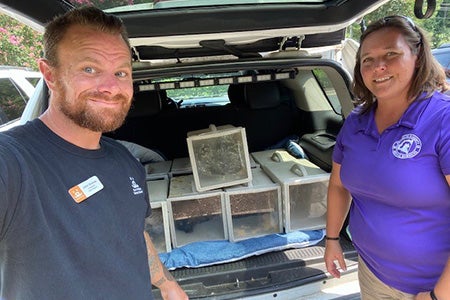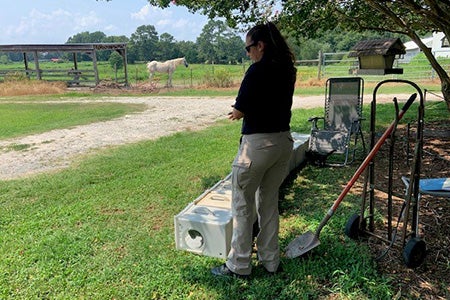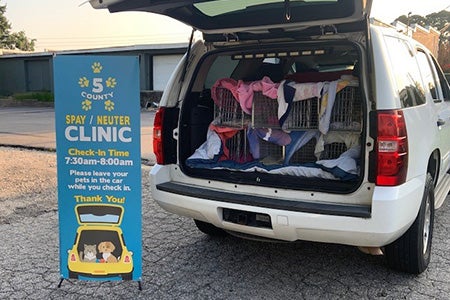Embed program helps cats and people who love them in North Carolina

When the Best Friends National Embed Program team learned that Franklin County Animal Services in North Carolina was having a challenging time helping cats in the community, it quickly saw beyond the obstacles to solutions. Not only would these solutions save more cats, but they would, hopefully, inspire Franklin County residents to embrace trap-neuter-vaccinate-return (TNVR).
“The save rate for cats in 2020 was 42%,” says Marla Browne, Best Friends National Embed Program manager. “But there were a lot of opportunities and staff desire to get that much higher.”
After connecting with Lynn Bowling, the shelter’s director, Marla, along with Best Friends regional strategist John Graves, devised a plan to help the shelter create and implement an initiative to save cats in Franklin County. The plan included easy access to free spay/neuter surgeries and vaccinations for community cats, humane deterrents for residents who didn’t want cats on their property and ongoing staff training so the team could help residents who wanted to take care of cats in their neighborhoods.
[Strong relationships save lives in Tulsa during a distemper outbreak]
“These tools have made all the difference in the world,” Lynn says of the national embed program that’s made possible in part by a grant from Maddie’s Fund®. “With Best Friends’ help, we have been able to turn things around and get the community involved, too.”

Saving cats with TNVR in Franklin County, North Carolina
Before the partnership with Best Friends began, there were limited opportunities for community cats in Franklin County to be spayed or neutered and vaccinated. This alone was enough to keep the number of cats in the community high and the cat save rate at the shelter low. Complicating this reality was the fact that the shelter did not have the capacity to do in-house spay/neuter surgeries.
“This was one of the first things we needed to work out,” says Marla. Through funding from Best Friends, the shelter was able to begin offering spay/neuter surgeries and vaccines a few times a week at private veterinary clinics. And once a month, a mobile spay/neuter organization came to the shelter to do additional surgeries.
Now, when residents contact the shelter for help with community cats living on or near their property, the shelter team can immediately schedule spay or neuter surgery and vaccines (for cats who aren’t ear-tipped, which indicates they have already been spayed or neutered). “Cats don’t come in only one day of the week. They trickle in throughout the week,” says Marla. “Being able to help those cats quickly is the best option.”

Guidance, training for shelter team
The shelter has always had strong support from the Franklin County sheriff. And today they have plenty of support from the community, too. In fact, Lynn estimates that about 90% of the time when residents call with concerns about cats on their property, the shelter team can provide a solution that works for them, and the cats, too.
[Prison program, trainers, put adoption in the stars for spirited dog]
Usually this involves scheduling a time for residents to bring in cats for spay/neuter and vaccines, as well as providing resources to help them care for cats once they are returned to their neighborhood.
This is where training and guidance from Best Friends comes in. When the partnership kicked off, John visited the shelter and worked closely with the shelter staff and animal services officers on how to handle complaints from community members frustrated with cats on their property.
The embed team also provided extensive training on everything from understanding cat body language to determining eligibility for cats to be returned to their community after spay/neuter, vaccinations and ear-tipping. And since returning the cat (regardless of temperament) is often the best outcome, the shelter team also learned how to get comfortable with releasing friendly cats back into the community.
“The staff was very engaged and asked a lot of great questions,” says John, who spent two days visiting neighborhoods with animal services officers and talking to people to find out where community cats were living and how they could help. “Mitigation solves problems. It’s about working together to find a long-term solution.”

North Carolina residents get on board for cats
Lynn says Best Friends’ help came at an ideal time, just as the tiny but mighty shelter team (Lynn and three full-time staff) began making changes. “COVID has given us the opportunity to focus on community outreach,” she says.
Today, when people contact the shelter asking for help with cats on their property, the shelter staff can offer solutions, including guidance on how to trap the cats, free spay/neuter surgeries, free vaccinations and Best Friends-funded humane deterrents designed to help the cats stay out of yards.

“First, we utilize the training that we learned from Best Friends,” says Lynn. “We try to get personal with (residents) and encourage them to let the cats remain on their property.”
Of course, not everyone they’ve helped has been quick to come on board. For example, one homeowner called up the shelter adamant that the cats on his property be removed permanently. But after talking to the staff, he agreed to take advantage of the shelter’s TNVR program.
[Collaboration helps a big colony of cats, and their caregiver, too]
Today that homeowner isn’t just an advocate for TNVR, he donates to the shelter’s food pantry whenever he can. And he’s not alone. Now Lynn says there’s more support than ever before from the community to help cats through TNVR.
“It’s just been a really awesome collaboration between Best Friends and the shelter,” says Marla, who reports that today the save rate for cats is nearly double what it was back in 2020. “The shelter team just took the ball and ran with it, and they’ve done a phenomenal job.”

Be a cat advocate
Take action by helping community cats where you live and help save lives.
Read more
9 ways pets tell you they love you
Senior dog with a heart of gold has new home
Bunny with a head tilt gets second chance at Best Friends
Photos courtesy of Lynn Bowling